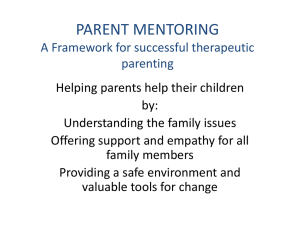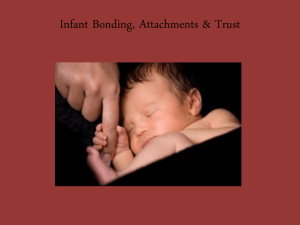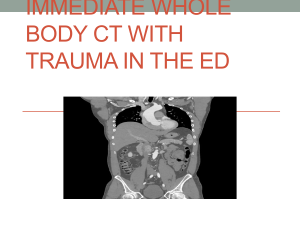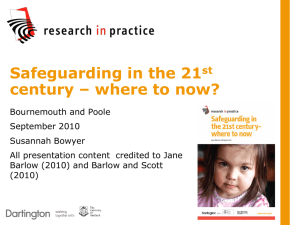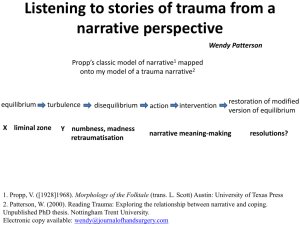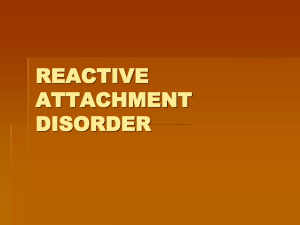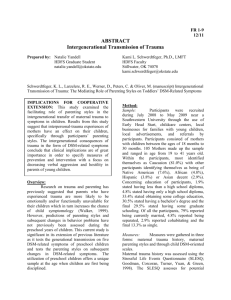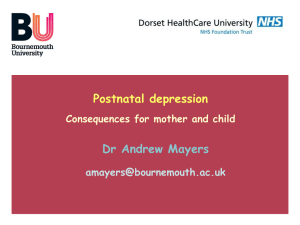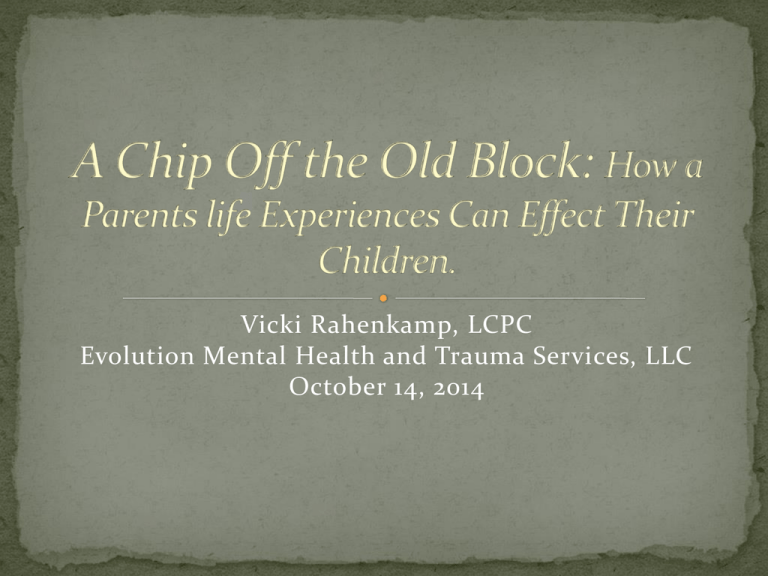
Vicki Rahenkamp, LCPC
Evolution Mental Health and Trauma Services, LLC
October 14, 2014
Trauma
Adverse Childhood experiences (ACE)
What are they?
Did a parent or other adult in the household often or very often… Swear at you, insult you, put you
down, or humiliate you? or Act in a way that made you afraid that you might be
physically hurt?
Did a parent or other adult in the household often or very often… Push, grab, slap, or throw
something at you? or Ever hit you so hard that you had marks or were injured
Did an adult or person at least 5 years older than you ever… Touch or fondle you or have you
touch their body in a sexual way? or Attempt or actually have oral, anal, or vaginal
intercourse with you
Did you often or very often feel that … No one in your family loved you or thought you were
important or special? or Your family didn’t look out for each other, feel close to each
other, or support each other
Did you often or very often feel that … You didn’t have enough to eat, had to wear dirty clothes,
and had no one to protect you? or Your parents were too drunk or high to take care of
you or take you to the doctor if you needed it?
Was a biological parent ever lost to you through divorce, abandonment, or other reason ?
Was your mother or stepmother: Often or very often pushed, grabbed, slapped, or had
something thrown at her? or Sometimes, often, or very often kicked, bitten, hit with a
fist, or hit with something hard? or Ever repeatedly hit over at least a few minutes or
threatened with a gun or knife?
Did you live with anyone who was a problem drinker or alcoholic, or who used street drugs?
enter
Was a household member depressed or mentally ill, or did a household member attempt
suicide?
Did a household member go to prison? Yes
Parent deployed to the war
Hospitalization
Death of a pet
Frequent moves
Poverty
Community violence
Health issues of a parent.
The more experiences the greater the trauma.
Puts your child’s behavior into context.
Helps us target the problem behavior and not the “bad
kid”.
Helps us see the behaviors as a family dynamic issue
and not focused on an individual .
His stuff + My stuff = New stuff (our families stuff).
2. Entitlements, what does this mean?
3. Emotional triggers (yours and theirs).
4. Bonding and attachment impacted by:
1.
5.
Temperment (parent vs child).
Parents bonding with their own parents (we do what
we learn).
Parent depression.
Parental stress/anxiety
Special enduring form of “emotional”relationship
with a specific person
Involves soothing, comfort and pleasure
Loss or threat of loss of the specific person evokes
distress
The child finds security and safety in the context of
this relationship.
( Bruce Perry, Child Trauma Academy)
Simply stated, bonding is the process of forming an
attachment. Just as bonding is the term
used when gluing one object to another, bonding is
using our “emotional glue” to become
connected to another. Bonding, therefore, involves a set
of behaviors that will help lead to
an emotional connection (attachment).
(Bruce Perry, Child Trauma Academy)
An emotionally and physically healthy mother will:
1.
2.
3.
4.
5.
Be drawn to her infant
She will feel a physical longing to smell, cuddle, rock, coo and gaze at
her infant.
In turn the infant will respond with snuggling, babbling, smiling,
sucking and clinging.
In most cases, the mother's behaviors bring pleasure, soothing and
nourishment to the infant and the infant's behaviors bring pleasure and
satisfaction to the mother.
This reciprocal positive feedback loop, this maternal-infant dance, is
where attachment develops.
Therefore, despite the genetic potential for bonding and attachment, it is the
nature, quantity, pattern and intensity of early life experiences that express that
genetic potential.
Without predictable, responsive, nurturing and sensory-enriched caregiving,
the infant's potential for normal bonding and attachments will be unrealized.
Stop sending emotional signals
Self soothe(thumb sucking or rocking)
Learn that they can not draw responses from
others, mom unreliable, world untrustworthy.
Children of depressed moms are at a risk for
emotional and cognitive delays
As infants: sleep more, elevated startle reactions,
show less interest.
Show less upset when separated from mom.
Depressed mother’s often ignore or override baby’s
emotional signals. They can be:
Punitive
See baby’s as bothersome, and hard to care for.
Feel their lives are out of control
Less motivation to explore environment
Prefer less challenging tasks.
As toddlers engage in low levels of symbolic play.
Grow poorly
Behavior problems that last into adolescence
Risk of becoming depressed.
Alterations in brain growth and organization. Specifically:
smaller frontal-occipital circumference and cortical
atrophy
Smaller hippocampus
Smaller corpus callosum
These alterations in brain growth lead to problems with:
Impulse control
Cause and effect
Executive functioning
Emotion regulation
Empathy
Cognitive skills-due to deficits in long and short-term
memory.
1.
2.
3.
4.
5.
Family therapy vs child only treatment
Individual therapy for parent/parents
Positive parenting vs punitive parenting
Identifying what the “pay off” for the child’s behavior
Early intervention
Intergenerational Trauma-Focused Parenting Program
Serving Parents who have experienced Childhood trauma (sexual, physical and extreme neglect)
Length: Families will be served for 1-3 years depending on severity of the symptoms (pilot program will run 6 months)
Referral source: Families will be referred through Health Dept. Healthy families program and perhaps local
pediatricians and hospitals. (Pilot program Healthy families).
Number of families: Based on funding available (pilot program 10 families).
Program Outline
Families will be referred to the program through Healthy Families, based on their screening
process. A referral form will be designed in conjunction with Healthy Families and will be used
to refer families to the program.
Once referral is received an in-home parent coach will be assigned and they will meet with the
family for an intake session, during this session the PSI (Parenting Stress Index), and the TSI
(Trauma Symptoms Inventory) or TSCC (Trauma Symptoms Checklist for children) if the parent
is under the age of 18. Families will also fill out intake paperwork and review program objective
and expectations during this session.
Families will receive:
Weekly (1.5 hrs) in-home family therapy and parenting education ( psycho-education and
modeling). Family therapy used will be Contextual family therapy and Parent- Child
Psychotherapy, which addresses intergenerational trauma and impact of families of origin.
Parent education will be based on PSI Parent program.
Topics addressed (education and modeling) using intensive 1-1 engagement:
How our trauma affects parenting
Healthy bounding and attachment
Child development and healthy expectations
Parent-child boundaries
Positive parenting skills
Weekly individual therapy for parent, using TF Psychotherapy and TF-CBT. Session will be offered in
the home, but can happen in the office if family prefers. Focus of the individual therapy is on parents
past trauma symptom resolution.
Therapy addresses:
Normal TF therapy to address parent part trauma
Psycho-education on intergenerational trauma
Psycho-education on how parent symptomology affects child development and behavior
(specifically regulation and anxiety).
1.
Bi-weekly parent group at office (childcare provided). Group consists of parent support, psychoeducation, and a music therapy component (stress reduction).
2.
Child care for the children will be structured and focus emotion regulation.
Healthy Families MidShore
Initiative began in 1999 through Healthy Families America
and Queen Anne’s County Community Partnerships with
Families and Children through Queen Anne’s County
Health Department.
Then partnered with Talbot County Health Department in
conjunction with Talbot Family Network.
Began serving families in both counties in January 2000 to
Queen Anne’s and Talbot Counties
Expanded to Kent County in July 2013.
Our Vision: All children receive nurturing care
from their family essential to leading a
healthy and productive life.
Our Mission: To promote child well-being and
prevent the abuse and neglect of our
counties’ children through home visiting
services.
Core Values:
Valuing Children
Strengthening Families
Engaging Communities
TARGET POPULATION
1st time parents who reside in Queen Anne’s, Talbot
& Kent Counties who are eligible for Maryland
Children’s Health Program or uninsured.
Have risk because of their own history of abuse as a
child, current or past mental illness, substance
abuse issues, anger control problems, inadequate
support, high stress, limited knowledge about
child development and other risk factors.
The assessment process addresses 10 areas discussed in
a conversation between the FAW and the potential
participant during a home visit.
10 Areas
Parents’ childhood experiences
Lifestyle behaviors and mental health
Parenting experience, prior CPS involvement
Coping skills and support system
Current stressors
Anger management skills
Expectations of infant’s development and milestones
Plans for discipline
Perception of new infant
Bonding and attachment
The tool has been standarized and validated as an
indicator of risk of child maltreatment.
A score of 0,5 or 10 is given to each topic.
Must score a 25 or higher to be eligible for services.
Home visitors teach parents about parenting and
child development using the Growing Great Kids
curriculum.
Use on-going positive, strength-based relationships
to promote growth and change in families.
Some of the programs outcomes:
Decrease child abuse and neglect
Healthy birth weights
Completed immunizations
Improved safety in the home
Increased parent knowledge of child development
Lessons Learned
Healthy Families have very hard to reach families. Not
all of the 10 families referred engaged in the “fACES”
program.
It is hard for the families to establish trusting
relationships with others
Families do not know the difference between therapy
and trauma-informed therapy
The home visitors and therapists need to meet more
often to discuss barriers, challenges and successes.
Suggested to schedule home visits back to back.
It is difficult to get the at-risk families to groups
So What Next????
1.
Statistics so far (Three months)
2.
Starting program in a residential setting
3.
Long term hopes/
Evolution Mental Health and Trauma Services, LLC
10 West Dover St 2nd FL, Easton MD 21601
410-820-4280
vrahenkamp@yahoo.com

